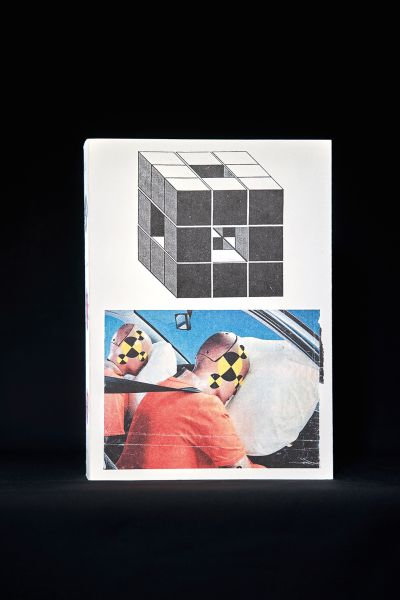Peter Radelfinger
Falsche Fährten
- Kategorie
- Honorary Appreciation
Begründung der Jury
★
Germany /// Deutschland
★
With the gravitational force of a freshly copied doctoral thesis, this chunky block sticks to the desk, as thick as a pack of A4 paper—at least that is your spontaneous impression. If you follow up this red herring (it is actually art) there is still the chance that you will come to the right conclusion.
On hundreds of double pages, there are text quotations on the left-hand side and four pictures on the right-hand side. Each quote has been given a shelf mark. The artist is an obsessive collector of pictures and text, and his encyclopaedic compilation seems to be catalogued entirely at random. Towards the end of the collection, the objective, simple intervals in the text/image arrangement are disturbed only slightly, but decisively. The text and image pages are swapped around because the extensive index already begins while the image material continues to spread out—a subtle expansion of the reference structure. In the old days we went through the thick Brockhaus lexicon, going from word to word and illustration to illustration just out of boredom, and then we intertwined all the associations offered higgledy-piggledy through the volume in order to have traced the Gordian knot of world knowledge.
What seems like ridiculous time-wasting from the perspective of our hyperlinked digital universe turns this book into a comprehensible catapult for realisations: “There are two points that are far apart in the moment that an idea appears—not knowing how they should communicate with one another—and then, after sufficient transformations, all of a sudden they are next to each other …”
★
Mit der Schwerkraft einer frischkopierten Doktorarbeit klebt der Klotz auf der Tischplatte, so dick wie ein Packen DinA4-Kopierpapier, so jedenfalls erscheint der spontane Eindruck. Wenn man auf dieser falschen Fährte die Witterung aufnimmt – es handelt sich hier um Kunst – besteht dennoch die Chance, die richtigen Schlüsse zu ziehen.
Auf hunderten von Doppelseiten stehen linkseitig zitierte Texte, rechtseitig je vier Bildzitate, jedes Zitat mit einer Signatur versehen. Der Künstler ist ein obsessiver Bild- und Textsammler, sein enzyklopädischer Fundus scheint willkürlich katalogisiert zu sein. Aber gegen Ende der Sammlung wird die objektive, simple Taktung der Text-Bild-Aufteilung kaum merklich, aber entscheidend gestört. Text- und Bildseiten tauschen sich, weil das umfangreiche Register schon beginnt, während sich das Bildmaterial weiterhin ausbreitet – eine subtile Erweiterung der Verweisstruktur. Früher hangelte man sich aus Langeweile im dicken Brockhaus von einem Stichwort zum anderen und von einer Abbildung zur nächsten, dann flocht man alle Assoziationsangebote kreuz und quer durch den Wälzer, um am Ende den gordischen Knoten des Weltwissens nachgezeichnet zu haben.
Was angesichts des hyperverlinkten Digitaluniversums als belächelnswerter Zeitvertreib erscheint, macht aus diesem Buch eine begreifbare Erkenntniszündmaschine: »Da sind zwei Punkte, die im Moment einer Idee weit auseinanderliegen – nicht wissend, wie sie miteinander kommunizieren sollen – und dann, nach hinreichenden Transformationen, zack: liegen sie beieinander …«

